2016 SUBARU OUTBACK Power
[x] Cancel search: PowerPage 9 of 572
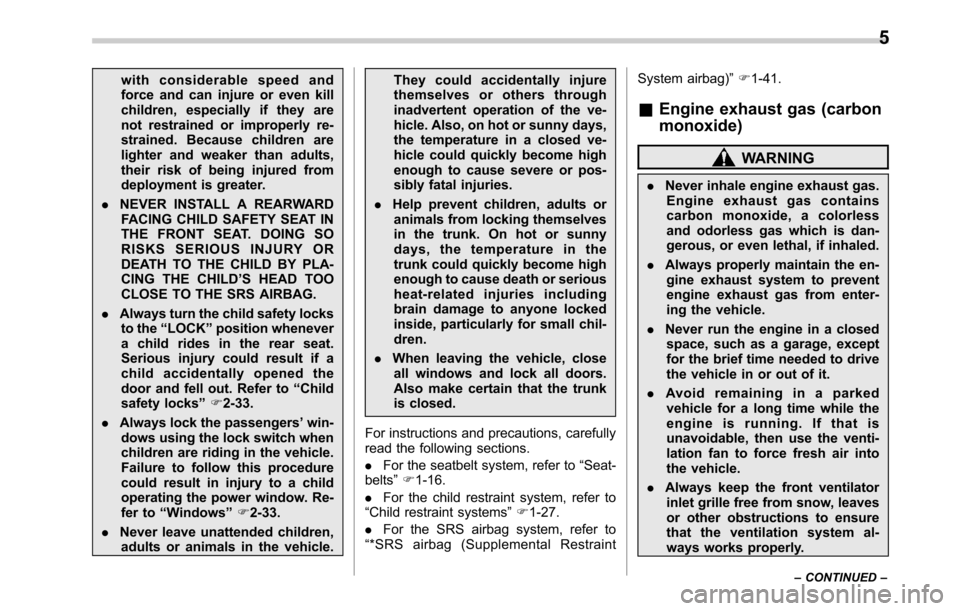
with considerable speed and
force and can injure or even kill
children, especially if they are
not restrained or improperly re-
strained. Because children are
lighter and weaker than adults,
their risk of being injured from
deployment is greater.
.NEVER INSTALL A REARWARD
FACING CHILD SAFETY SEAT IN
THE FRONT SEAT. DOING SO
RISKS SERIOUS INJURY OR
DEATH TO THE CHILD BY PLA-
CING THE CHILD’S HEAD TOO
CLOSE TO THE SRS AIRBAG.
.Always turn the child safety locks
to the“LOCK”position whenever
a child rides in the rear seat.
Serious injury could result if a
child accidentally opened the
door and fell out. Refer to“Child
safety locks”F2-33.
.Always lock the passengers’win-
dows using the lock switch when
children are riding in the vehicle.
Failure to follow this procedure
could result in injury to a child
operating the power window. Re-
fer to“Windows”F2-33.
.Never leave unattended children,
adults or animals in the vehicle.They could accidentally injure
themselves or others through
inadvertent operation of the ve-
hicle. Also, on hot or sunny days,
the temperature in a closed ve-
hicle could quickly become high
enough to cause severe or pos-
sibly fatal injuries.
.Help prevent children, adults or
animals from locking themselves
in the trunk. On hot or sunny
days, the temperature in the
trunk could quickly become high
enough to cause death or serious
heat-related injuries including
brain damage to anyone locked
inside, particularly for small chil-
dren.
.When leaving the vehicle, close
all windows and lock all doors.
Also make certain that the trunk
is closed.
For instructions and precautions, carefully
read the following sections.
.For the seatbelt system, refer to“Seat-
belts”F1-16.
.For the child restraint system, refer to
“Child restraint systems”F1-27.
.For the SRS airbag system, refer to
“*SRS airbag (Supplemental RestraintSystem airbag)”F1-41.
&Engine exhaust gas (carbon
monoxide)
WARNING
.Never inhale engine exhaust gas.
Engine exhaust gas contains
carbon monoxide, a colorless
and odorless gas which is dan-
gerous, or even lethal, if inhaled.
.Always properly maintain the en-
gine exhaust system to prevent
engine exhaust gas from enter-
ing the vehicle.
.Never run the engine in a closed
space, such as a garage, except
for the brief time needed to drive
the vehicle in or out of it.
.Avoid remaining in a parked
vehicle for a long time while the
engine is running. If that is
unavoidable, then use the venti-
lation fan to force fresh air into
the vehicle.
.Always keep the front ventilator
inlet grille free from snow, leaves
or other obstructions to ensure
that the ventilation system al-
ways works properly.
–CONTINUED–
5
Page 17 of 572
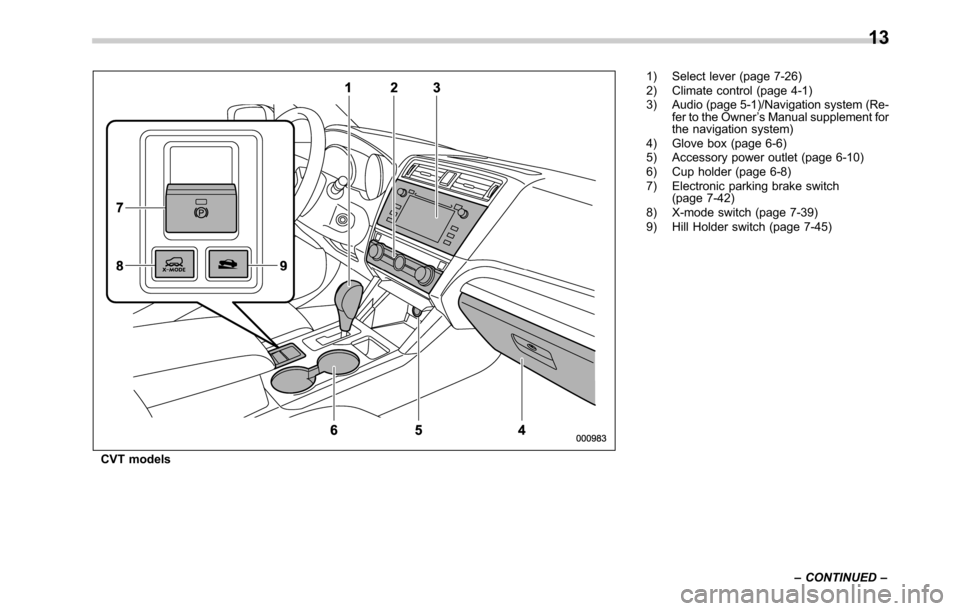
CVT models1) Select lever (page 7-26)
2) Climate control (page 4-1)
3) Audio (page 5-1)/Navigation system (Re-
fer to the Owner’s Manual supplement for
the navigation system)
4) Glove box (page 6-6)
5) Accessory power outlet (page 6-10)
6) Cup holder (page 6-8)
7) Electronic parking brake switch
(page 7-42)
8) X-mode switch (page 7-39)
9) Hill Holder switch (page 7-45)
–CONTINUED–
13
Page 18 of 572
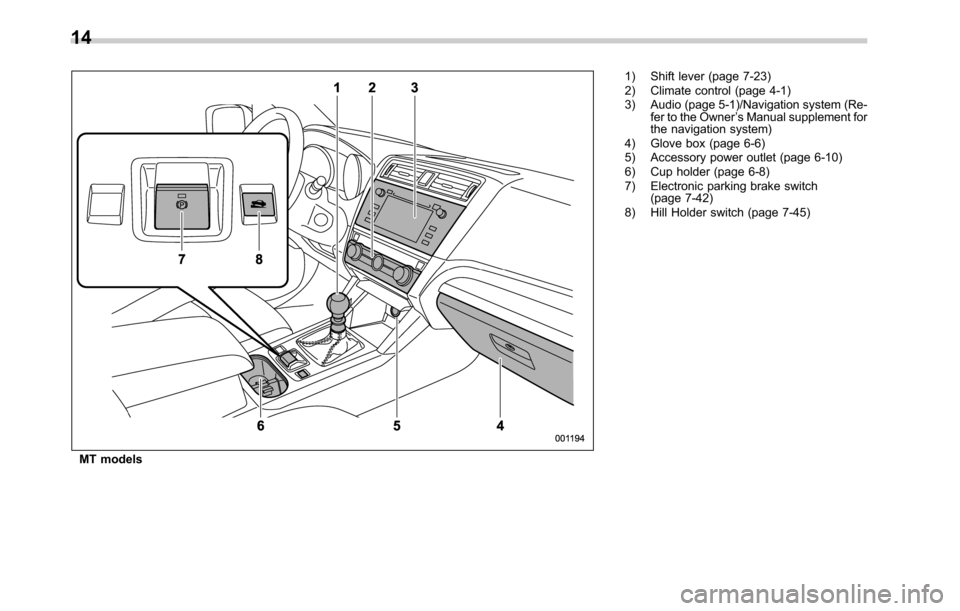
MT models1) Shift lever (page 7-23)
2) Climate control (page 4-1)
3) Audio (page 5-1)/Navigation system (Re-
fer to the Owner’s Manual supplement for
the navigation system)
4) Glove box (page 6-6)
5) Accessory power outlet (page 6-10)
6) Cup holder (page 6-8)
7) Electronic parking brake switch
(page 7-42)
8) Hill Holder switch (page 7-45)
14
Page 20 of 572
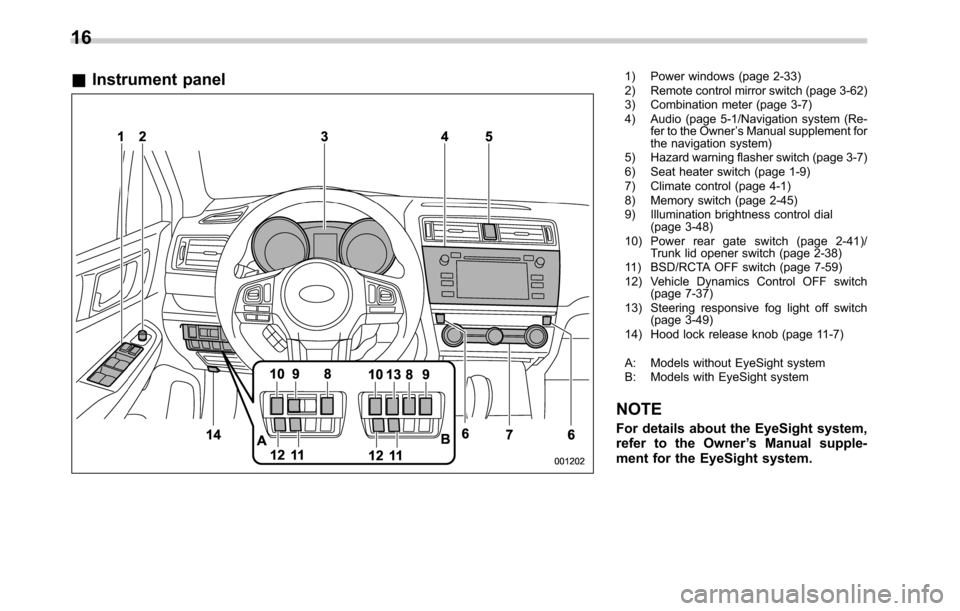
&Instrument panel1) Power windows (page 2-33)
2) Remote control mirror switch (page 3-62)
3) Combination meter (page 3-7)
4) Audio (page 5-1/Navigation system (Re-
fer to the Owner’s Manual supplement for
the navigation system)
5) Hazard warning flasher switch (page 3-7)
6) Seat heater switch (page 1-9)
7) Climate control (page 4-1)
8) Memory switch (page 2-45)
9) Illumination brightness control dial
(page 3-48)
10) Power rear gate switch (page 2-41)/
Trunk lid opener switch (page 2-38)
11) BSD/RCTA OFF switch (page 7-59)
12) Vehicle Dynamics Control OFF switch
(page 7-37)
13) Steering responsive fog light off switch
(page 3-49)
14) Hood lock release knob (page 11-7)
A: Models without EyeSight system
B: Models with EyeSight system
NOTE
For details about the EyeSight system,
refer to the Owner’s Manual supple-
ment for the EyeSight system.
16
Page 27 of 572

&Warning and indicator lights
Mark Name Page
Seatbelt warning light 3-12
Front passenger’s
seatbelt warning light3-12
SRS airbag system
warning light3-14
CHECK ENGINE warn-
ing light/Malfunction in-
dicator light3-15
Charge warning light 3-15
Oil pressure warning
light3-15
Engine low oil level
warning indicator3-16
AT OIL TEMP warning
light (CVT models)3-16
/ABS warning light 3-18
/Brake system warning
light3-18Mark Name Page
/Electronic parking
brake indicator light3-20
Hill Holder indicator
light3-21
Door open indicator 3-22
Low fuel warning light 3-21
All-Wheel Drive warn-
ing light (CVT models)3-22
Power steering warning
light3-22
Vehicle Dynamics Con-
trol warning light/Vehi-
cle Dynamics Control
operation indicator light3-23
Vehicle Dynamics Con-
trol OFF indicator light3-24
Access key warning in-
dicator (if equipped)3-24
Security indicator light 3-29
Turn signal indicator
lights3-30Mark Name Page
High beam indicator
light3-30
Automatic headlight
beam leveler warning
light (if equipped)3-30
Front fog light indicator
light (if equipped)3-31
Cruise control indicator 3-30
Cruise control set indi-
cator3-30
X-mode indicator (if
equipped)3-31
Hill descent control in-
dicator (if equipped)3-31
Headlight indicator light 3-31
Low tire pressure
warning light (U.S.
spec. models)3-16
/Front passenger’s fron-
tal airbag ON indicator
light3-14
/Front passenger’s fron-
tal airbag OFF indicator
light3-14
–CONTINUED–
23
Page 30 of 572

Item Function Possible settings Default setting Page
Defogger and deicer system Rear window defogger, out-
side mirror defogger and
windshield wiper deicerOperation for 15 minutes/
Continuous operationOperation for 15 minutes 3-54, 3-42
Map light/Dome light/Cargo
area lightOperation of map light/dome
light/cargo area light OFF de-
lay timerOFF/Short/Normal/Long Long 6-4, 3-42
Battery drainage prevention
functionBattery drainage prevention
functionOperation/Non-operation Operation 2-8
Auto on/off headlights Sensitivity of the operation of
the auto on/off headlightsMin/Low/Mid/Max Mid 3-44, 3-42
Windshield wiper Automatic headlight turn on
function that is linked with
wiper operationOperation/Non-operation Operation 3-44, 3-42
Auto dimmer cancel Sensitivity of the operation of
the auto dimmer cancelOFF/Min/Low/Mid/Hi/Max Mid 3-48
Welcome lighting function Welcome lighting function
(when approaching)OFF/30 seconds/60 seconds/
90 seconds30 seconds 3-42, 3-44
Welcome lighting function
(when exiting)OFF/30 seconds/60 seconds/
90 seconds30 seconds
Reverse gear interlocked rear
wiperReverse gear interlocked rear
wiper operationOperation/Non-operation U.S.-spec. models: Non-operation
Other models: Operation3-53
One-touch lane changer Operation of the one-touch
lane changerOperation/Non-operation Operation 3-48
*1: If equipped
*2: This setting also works as the ON/OFF setting of the power rear gate buzzer for starting operation. However, you cannot change the warning buzzer
setting for a detecting jam, etc.
*3: The audible signal volume cannot be set under level 5 for the warning chime.
26
Page 31 of 572

Front seats........................................................... 1-2
Manual seat (if equipped).................................... 1-4
Power seat (if equipped)...................................... 1-5
Head restraint adjustment.................................... 1-8
Seat heater (if equipped).................................... 1-9
Front seat heater (if equipped)............................ 1-10
Rear seat heater (if equipped)............................. 1-10
Rear seats........................................................... 1-11Reclining the seatback (Outback)........................ 1-11
Folding down the rear seatback.......................... 1-12
Head restraint adjustment................................... 1-14
Armrest............................................................. 1-15
Seatbelts............................................................. 1-16Seatbelt safety tips............................................. 1-16
Emergency Locking Retractor (ELR)................... 1-17
Automatic Locking Retractor/Emergency Locking
Retractor (ALR/ELR)......................................... 1-17
Seatbelt warning light and chime........................ 1-17
Fastening the seatbelt........................................ 1-17
Seatbelt maintenance......................................... 1-24
Front seatbelt pretensioners............................. 1-24System monitors................................................ 1-26
System servicing................................................ 1-26Precautions against vehicle modification............ 1-27
Child restraint systems..................................... 1-27Where to place a child restraint system.............. 1-28
Choosing a child restraint system...................... 1-30
Installing child restraint systems with ALR/ELR
seatbelt........................................................... 1-30
Installing a booster seat..................................... 1-34
Installation of child restraint systems by use of
lower and tether anchorages (LATCH).............. 1-35
Top tether anchorages....................................... 1-38
*SRS airbag (Supplemental Restraint
System airbag)................................................ 1-41
General precautions regarding SRS airbag
system............................................................ 1-41
Components...................................................... 1-48
SUBARU advanced frontal airbag system, SRS
seat cushion airbag, SRS side airbag and SRS
curtain airbag.................................................. 1-51
System operation............................................... 1-56
SRS airbag system monitors.............................. 1-68
SRS airbag system servicing ............................. 1-69
Precautions against vehicle modification............ 1-70
Seat, seatbelt and SRS airbags
1
Page 33 of 572
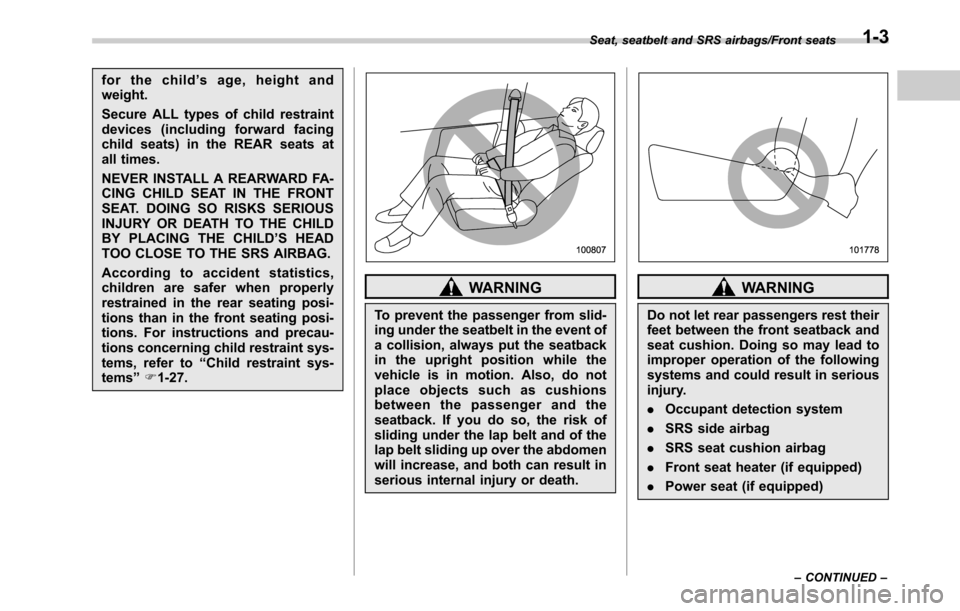
for the child’s age, height and
weight.
Secure ALL types of child restraint
devices (including forward facing
child seats) in the REAR seats at
all times.
NEVER INSTALL A REARWARD FA-
CING CHILD SEAT IN THE FRONT
SEAT. DOING SO RISKS SERIOUS
INJURY OR DEATH TO THE CHILD
BY PLACING THE CHILD’S HEAD
TOO CLOSE TO THE SRS AIRBAG.
According to accident statistics,
children are safer when properly
restrained in the rear seating posi-
tions than in the front seating posi-
tions. For instructions and precau-
tions concerning child restraint sys-
tems, refer to“Child restraint sys-
tems”F1-27.
WARNING
To prevent the passenger from slid-
ing under the seatbelt in the event of
a collision, always put the seatback
in the upright position while the
vehicle is in motion. Also, do not
place objects such as cushions
between the passenger and the
seatback. If you do so, the risk of
sliding under the lap belt and of the
lap belt sliding up over the abdomen
will increase, and both can result in
serious internal injury or death.
WARNING
Do not let rear passengers rest their
feet between the front seatback and
seat cushion. Doing so may lead to
improper operation of the following
systems and could result in serious
injury.
.Occupant detection system
.SRS side airbag
.SRS seat cushion airbag
.Front seat heater (if equipped)
.Power seat (if equipped)
Seat, seatbelt and SRS airbags/Front seats
–CONTINUED–1-3